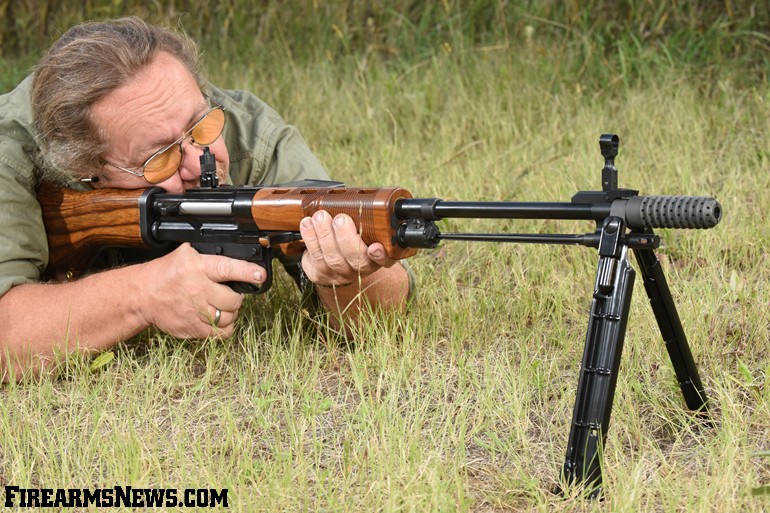The Lee Enfield series is generally considered the high water mark of military bolt action rifles. A tough, reliable design well-liked by the troops, it proved very effective during two World Wars and many smaller actions.
I’ve always been a fan of the Lee, and find it interesting how this 19th Century manually operated design had a small influence on arguably the most innovative rifle developed during World War II, the German Fallschirmjägergewehr 42 (Paratrooper rifle 1942) or FG 42. I was thinking about this while lying prone behind a modern FG 42 reproduction dialing the rear sight up to 700 meters.
In the far distance was my 800 yard berm with a number of steel targets. The FG 42 was sitting on its distinctive lightweight bipod, a fresh 20-round magazine jutting jauntily out from the left side of the receiver. Hauling back on the charging handle against the heavy recoil spring, I retracted the bolt and let it fly. The heavy bolt carrier assembly ran forward shoving a Hornady match load into the chamber. The rest of the world faded away. Now it was just this classic World War II rifle’s front sight, a faraway white steel silhouette and the building pressure of my finger on the trigger.
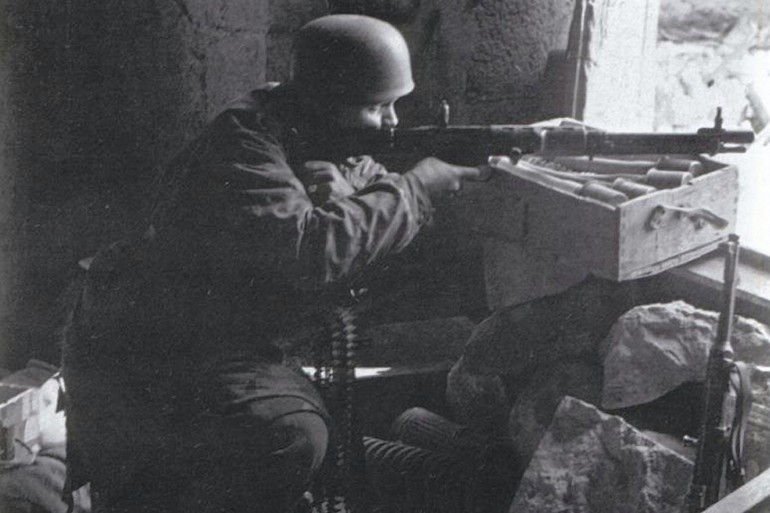
The global catastrophe we know as World War II begat many interesting small arms designs. Of these numerous models, the most influential proved to be Nazi Germany’s MP 43/44 and StG 44 series of Sturmgewehr (Storm or Assault rifle) chambered for the Polte 7.92x33mm Kurz cartridge. A revolutionary new type of weapon, the Sturmgewehr series combined the best features of the submachinegun and battle rifle into one compact package. As its long lasting legacy, both the Sturmgewehr and its 7.92x33mm Kurz cartridge were a direct influence on the Soviet AK47 and 7.62x39mm. As impressive as the MP 43/44 series is, in my humble opinion it pales in comparison design-wise to the much less well-known FG 42.
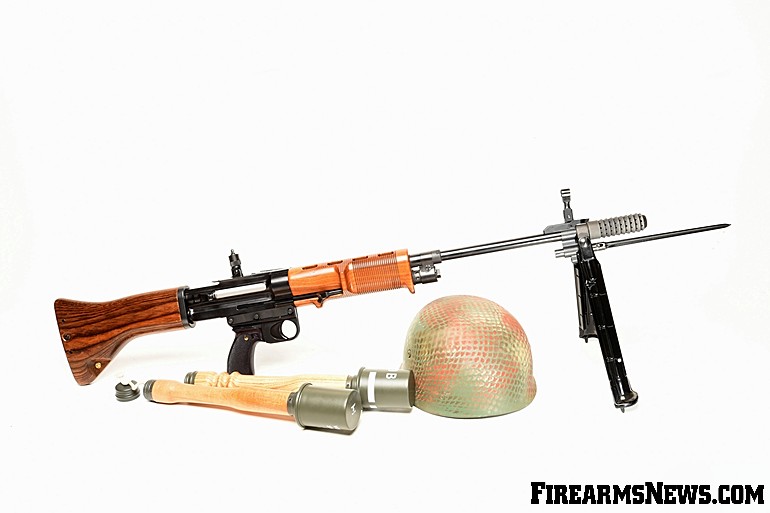
Why do I say this? Whereas the MP 43/44 and StG 44 combined the best features of the submachine gun and battle rifle, the FG 42 was part battle rifle and part light machine gun. In developing the FG 42 the engineers at Rheinmetall, and later Krieghoff, pushed the envelope reaching for what logically seems a bridge too far, and yet achieved it, to a degree. The result was a surprisingly compact selective-fire 7.9x57mm weapon with numerous advanced features. In combat it provided an over-match capability to the German Fallschirmjäger carrying it whether facing M1 Garands, SVT-40s or No. 4 Lee Enfields. Even today, the FG 42 looks remarkably contemporary despite being some 76 years old. Its legacy can be found inside the US M60 machine gun.

To understand the FG 42 we must travel back in time to 20 May 1941 and the Battle of Crete (Luftlandeschlacht um Kreta). The Germans launched Operation Mecury (Unternehmen Merkur) which was the first mass use of airborne forces in history. Their objective was drive the Greek and Allied defenders out and take the island in a lightening blow by landing troops in four zones. To make a long story short, the British and Commonwealth forces made some huge tactical blunders allowing the Germans to gain a foothold and then hold doggedly on. In the end Crete fell to the Axis Forces, but it came at a high price. The German’s suffered between 6,000 and 7,000 casualties and lost/wrote off approximately 284 aircraft with another couple hundred damaged. In the end it was not the easy victory the Luftwaffe had hoped for.
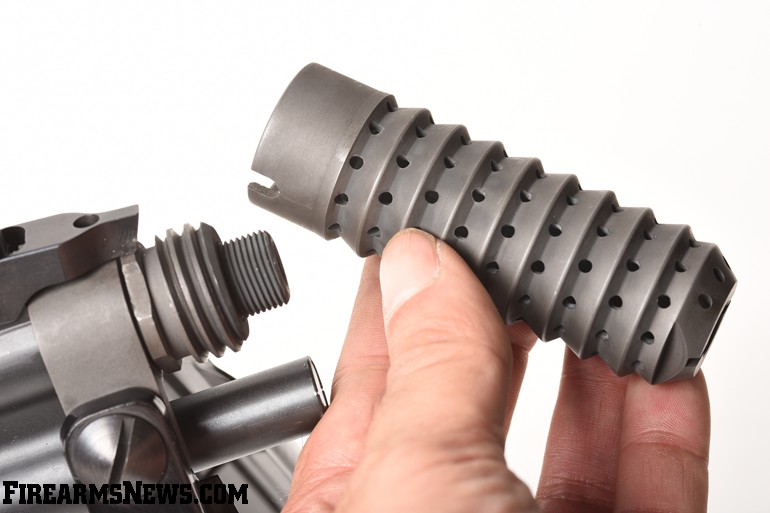
The Luftwaffe came away from Crete dissatisfied with the performance of the standard Wehrmacht infantry weapons issued to their elite troops. While the 7.92x57mm Kar 98k was capable at long range it had a slow rate of fire and limited magazine capacity. The MP 40 on the other hand lacked range, penetration and precision. The MG 34 was very effective but too few in number. So a decision was made by the Reichsluftfahrtministerium (Reich Air Ministry) to develop an entirely new multi-purpose weapon based upon the specific needs of the Luftwaffe. The new design would need to be compact and portable, possess the range and accuracy of a Kar 98k, and have the firepower of a light machine gun. Such a weapon would dramatically boost the firepower of the individual Fallschirmjäger and ease the logistics of resupply.
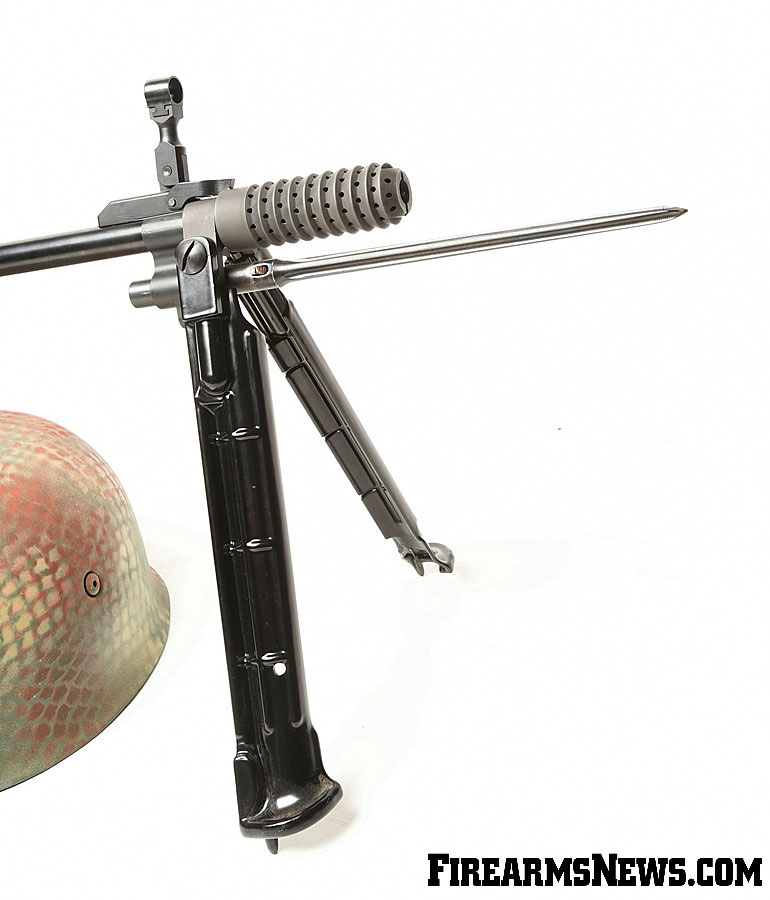
Initially the Luftwaffe intended to work with the German Army to initiate a formal project to develop a new weapon. However, the Army disagreed with the basic concept and expressed no interest in the project. They would eventually abandon the full-size 7.92x57mm cartridge and put their efforts into selective-fire weapons chambering intermediate size cartridges. Undeterred, the Luftwaffe bypassed the Heereswaffenamt (Army Ordnance Department) and went directly to German industry.
Krieghoff and Rheinmetall both responded by submitting prototypes based upon the Luftwaffe requirements. Of the two the Luftwaffe selected the Rheinmetall design. This is credited as having been designed by Louis Strange and was based upon the operating system of the World War I vintage Lewis Gun. A gas operated design; it utilized a bottom mounted long-stroke piston. Gas tapped from the barrel pushed this to the rear. The piston was fitted with a vertical post at its rear which rode in a cam track on the bolt. It rotated the bolt, which featured dual opposed locking lugs, unlocking it and extracting and ejecting the fired cartridge case before a recoil spring pushed it back forward loading another round into the chamber. Visually it was a great departure from traditional German rifles featuring an inline design, tall folding sights, sharply angled pistolgrip, stamped metal stock, side-mounted magazine, prominent muzzle brake and folding bipod.

Rheinmetall lacked the capacity to actually produce the rifle so Krieghoff was given this task. A batch of 50 was produced and testing began. From this point the FG 42’s design would remain fluid and ever-changing. While the designation FG 42 never changed, the rifle it designated evolved greatly based upon end-user feed-back, changing requirements of the Luftwaffe and the realities of wartime manufacturing. During its short production life the FG 42 saw small changes as well as a complete overhaul of the design due to the needs of manufacturing and to improve performance. The series is typically broken down simply as either early (Type I) or late (Type II) model. Approximately 2,000 early model guns were produced and approximately 5,000 late models. While they shared the same designation and general layout the two models are quite different if placed side by side.
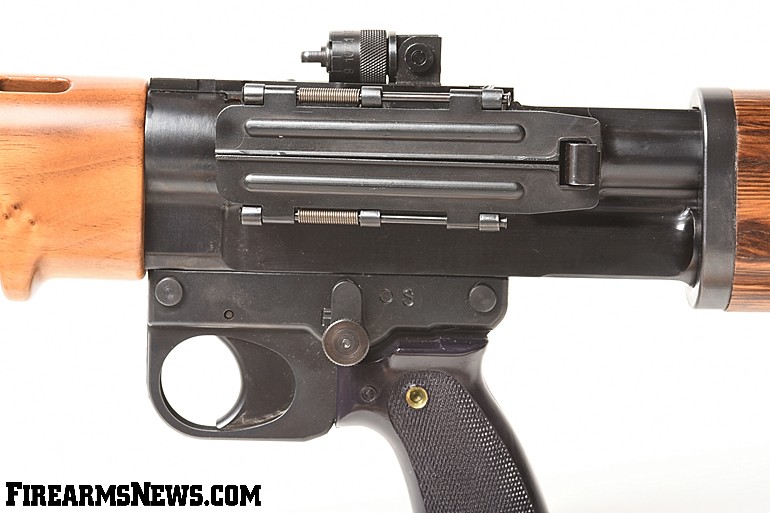
Some shortcomings of the design were noted by troops when the FG 42 was first fielded by the “Green Devils”. Due to its light weight (9.3 pounds) and high cycle rate of fire (900 rpm) the FG 42 couldn’t match the performance of the MG 34, or the new MG 42 machine gun when fired off the bipod. It was also less controllable on full automatic when fired from the shoulder than the Army’s new 7.92x33mm Kurz MP 43. So a more effective muzzle brake was desired. Troops felt the sharply angled pistolgrip, designed to reduce the height and chance of snagging during a jump, should be replaced by a more vertical one. It was also decided to move the bipod mount from the gas block to near the muzzle. This was done to decrease dispersion. Troops complained about the metal buttstock which heated quickly and also deformed when launching rifle grenades.
Video That May Interest You

The German Army did their own testing with the FG 42, comparing it to their MP 43. As to be expected, the 7.92x33mm Kurz MP 43 out-performed the 7.92x57mm FG 42 during the close combat trials. On the range both rifles performed similarly when firing on targets up to 400 meters. Past 400 meters the FG 42 had an advantage. However, it could not provide accurate fire on full-automatic at long range. Seeing as the MP 43 had matched the FG 42 out to 400 meters, and out-performed it in close-combat the German Army continued to oppose the project.
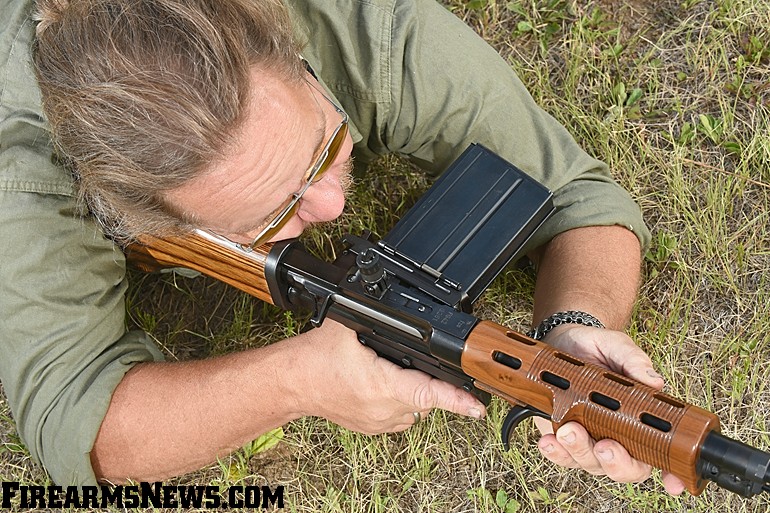
Despite the German Army’s position, the Luftwaffe’s Fallschirmjäger welcomed the design and appreciated the step up in performance it provided them. The FG 42 was first fielded during a daring commando raid during the rescue of Benito Mussolini. In the months following this small numbers saw action in Italy. The FG 42 gave a good account of itself during the Battle of Monte Cassino (17 January to 18 May 1944) in the hands of Fallschirmjäger defending the old monastery. This was ideal terrain for the FG 42 allowing it to showcase its full capabilities. The FG 42 also saw action in France during the hard fought hedgerow battles during the retreat from Normandy. It remained in combat with the hard-pressed Fallschirmjäger units, now fighting as conventional infantry, right up to Germany’s surrender on 7 May 1945.
What about major airborne operations which the FG 42 participated in? There were none. Fallschirmjäger losses during the Battle of Crete were so high Hitler decided airborne operations were no longer viable. While they didn’t know it in the aftermath of the battle, the Luftwaffe’s elite Fallschirmjäger units would spend the rest of the war fighting as conventional ground forces. After the war US Army ordnance took an interest in the operating system of the FG 42. It would later be incorporated in the US Army’s M60 machine gun. In doing so, Isaac Newton Lewis’s operating system, originally rejected by US Army Ordnance due to petty personal reasons became a staple of the US military.
